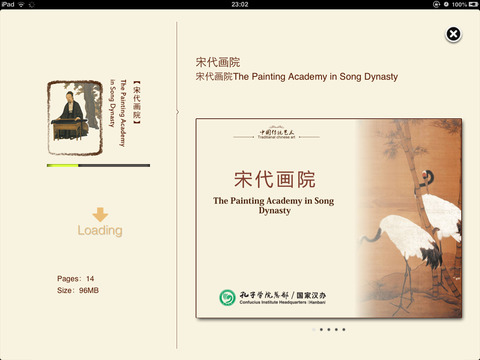
TraditionalArts app for iPhone and iPad
Developer: Beijing Founder Digital Art Co., LTD
First release : 17 Dec 2014
App size: 51.79 Mb
Dunhuang Frescoes
Dunhuang frescoes refer to frescoes in Dunhuang grottoes. Dunhuang grottoes mainly include Mogao Grottoes, Western Thousand Buddha Caves, and Anxi Yulin Grottoes, totally more than 50,000 square meters, are the caves with the most frescoes in China.
Han Dynasty Pottery Figurine
No matter the diversity, amount, material or skills of the pottery figurine, the craftsmanship of Han Dynasty had broken a new level, which was endowed with amazing artistic value and provided us the significant historical cultural value.
Calligraphy in Tang Dynasty
Chinese calligraphy is the writing art of Chinese characters in as well as a unique visual art. Since the creation of oracle bone script, the evolution process of Chinese character fonts go through Jin script, seal script, clerical script, regular script, running script and cursive script. At Tang Dynasty Chinese calligraphy arrived at its peak.
Grotto Art
The existing large-scale grottoes in China are mainly include Dunhuang Grottoes and Maiji Mountain Grottoes both in Gansu Province, Datong Yungang Grottoes in Shanxi Province, Longmen Grottoes in Henan Province.
The Painting Academy in Song Dynasty
Ancient China attached much importance on the traditional Chinese painting, the government set up a special institute which specialized in royal painting and selecting and cultivating professional painters. And Song Dynasty was the most prosperous time of the art academy in Chinese history.
Jade Carving
Jade carving refers to the process to carve a piece of jade into a fine article of art, and it is one of the oldest carving arts in China.
Blue and White Porcelain in Yuan and Ming Dynasties
Blue and White Porcelain, is a sort of Chinese porcelain belongs to colored porcelain. Yuan Dynasty is the mature period of blue and white porcelain and in Ming Dynasty, blue and white porcelain becomes the mainstream of porcelain.
Chinese Traditional Costumes
In ancient Chinese, “Yi” means the costume of the upper body and “Shang” means the costume of the lower part of the body, therefore, “Yi Shang” means costumes in Chinese. Yi in upper body and Shang in lower part of the body is the earliest clothing system in China.
The Four Chinese Classic Gardens
There are four classic gardens represent the achievements of Chinese classic garden art, they are the Humble Administrators Garden, the Lingering Garden, the Summer Palace, and Chengde Summer Resort.
Chinese Opera
Chinese opera is one of Chinese traditional arts, which is a dramatic form that centers on singing, recital, acting and acrobatic fighting.


